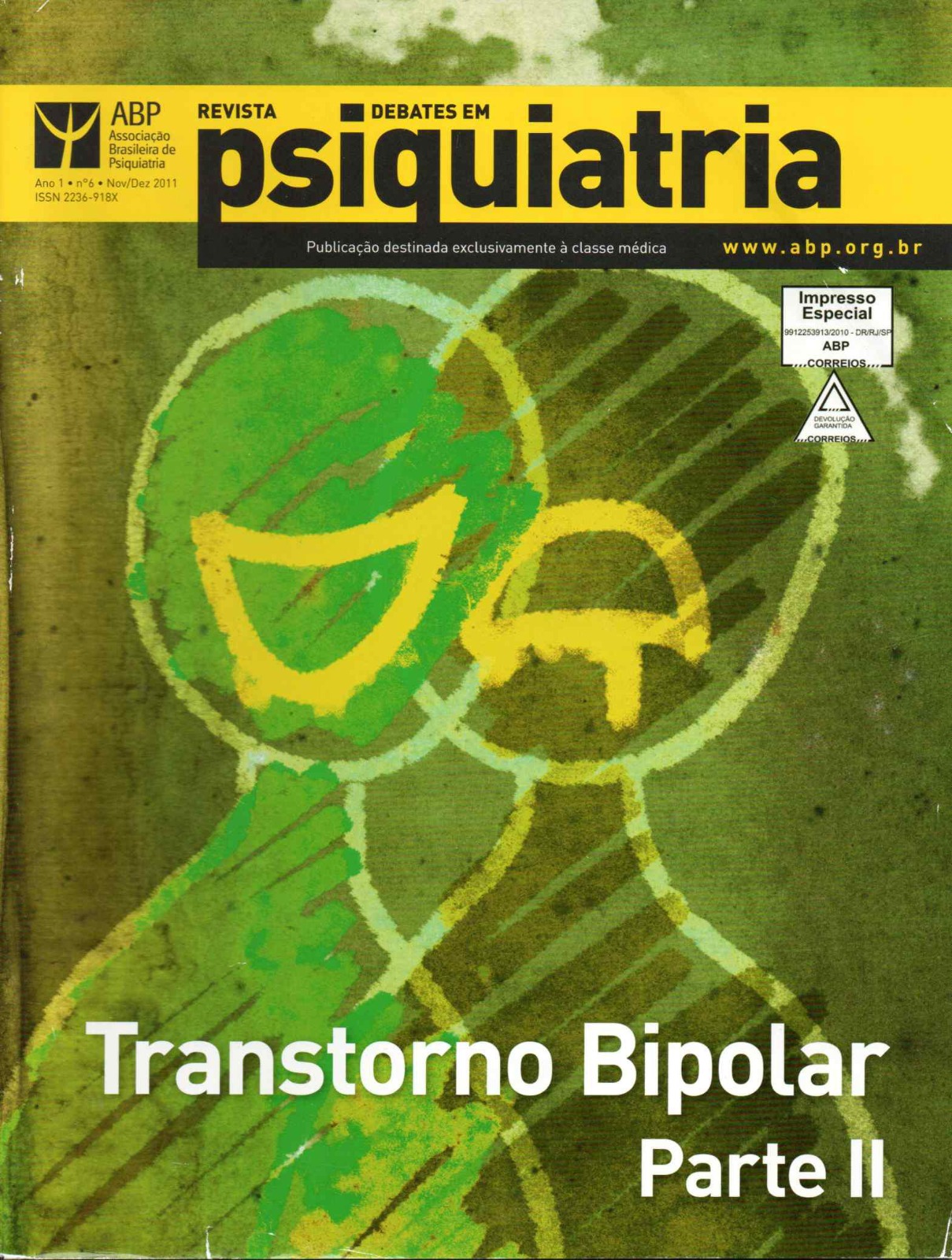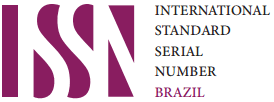Manejo del paciente en crisis.
DOI:
https://doi.org/10.25118/2763-9037.2011.v1.1425Palabras clave:
trastorno bipolar, depresión, suicidioResumen
.
Descargas
Métricas
Citas
1. ANGST F.; STASSEN HH; CLAYTON PJ; ANGST J. Mor-tality of patients with mood disorders: follow-up over 34-38 years. J Affect Disord. v.68. p.167-81. 2002. DOI: https://doi.org/10.1016/S0165-0327(01)00377-9
2. ANGST J; ANGST F; GERBER-WERDER R; GAMMA, A. Suicide in 406 mood-disorder patients with and wi-thout long-term medication: a 40 to 44 years’ follow--up. Arch Suicide Res. v.9. p.279-300. 2005. DOI: https://doi.org/10.1080/13811110590929488
3. Asberg M, Traskman L, Thoren P. 5-HIAA in the cere-brospinal fluid. A biochemical suicide predictor? Arch Gen Psychiatry. 1976;33(10):1193-7. DOI: https://doi.org/10.1001/archpsyc.1976.01770100055005
4. Azorin JM, Bowden CL, Garay RP, Perugi G, Vieta E, Young AH. Possible new ways in the pharmacological treatment of bipolar disorder and comorbid alcoho-lism. Neuropsychiatr Dis Treat. 2010 Mar 24;6:37-46. DOI: https://doi.org/10.2147/NDT.S6741
5. Baldaçara L, Sanches M, Cordeiro DC, Jackoswski AP. Rapid tranquilization for agitated patients in emer-gency psychiatric rooms: a randomized trial of olanza-pine, ziprasidone, haloperidol plus promethazine, ha-loperidol plus midazolam and haloperidol alone. Rev Bras Psiquiatr. 2011 Mar;33(1):30-9. DOI: https://doi.org/10.1590/S1516-44462011000100008
6. Bauer MS, Mitchner L. What is a “mood stabilizer”? An evidence-based response. Am J Psychiatry. 2004 Jan;161(1):3-18. DOI: https://doi.org/10.1176/appi.ajp.161.1.3
7. Blacker D, Tsuang MT. Contested boundaries of bipo-lar disorder and the limits of categorical diagnosis in psychiatry. Am J Psychiatry. 1992; 149(11):1473-1483 DOI: https://doi.org/10.1176/ajp.149.11.1473
8. Blumenthal SJ. Suicide: a guide to risk factors, asses-sment, and treatment of suicidal patients. Med Clin North Am 1988;72:937–71. DOI: https://doi.org/10.1016/S0025-7125(16)30754-4
9. Brent DA, Mann JJ. Family genetic studies, suicide, and suicidal behavior. Am J Med Genet C Semin Med Ge-net, 133:13-24, 20 05. DOI: https://doi.org/10.1002/ajmg.c.30042
10. Brzozowski FS, Soares BG, Benedet J, Boing AF, Peres MA. Suicide time trends in Brazil from 1980 to 2005. Cad. Saúde Pública, Rio de Janeiro, 26(7):1293-1302, jul, 2010. DOI: https://doi.org/10.1590/S0102-311X2010000700008
11. Cavazzoni P, Grof P, Duffy A, Grof E, Mu ̈ ller-Oerlin-ghausen B, Bergho ̈ fer A, Ahrens B, Zvolsky P, Robert-son C, Davis A, Hajek T, Alda M. Heterogeneity of the risk of suicidal behavior in bipolar spectrum disorders. Bipolar Disord 2007: 9: 377–385. DOI: https://doi.org/10.1111/j.1399-5618.2007.00516.x
12. Colom F, and Vieta, E. (2004). Melhorando o desfecho do transtorno bipolar usando estratégias não farma-cológicas: o papel da psicoeducação. Revista Brasileira De Psiquiatria (São Paulo, Brazil : 1999). 26: 47-50. DOI: https://doi.org/10.1590/S1516-44462004000700011
13. COLOM, F., VIETA, E J. SANCHEZ-MORENO, R. PALO-MINO-OTINIANO, M. REINARES, J.M. GOIKOLEA, A. BENABARRE, AND A. MARTINEZ-ARAN. (2009). “Group psychoeducation for stabilised bipolar disor-ders: 5-year outcome of a randomised clinical trial”. The British Journal of Psychiatry. 194 (3): 260-265. DOI: https://doi.org/10.1192/bjp.bp.107.040485
14. Fawcett J, Clark DC, Busch KA. Assessing and tre-ating the patient at risk for suicide. Psychiatr Ann 1993;23:244–55. DOI: https://doi.org/10.3928/0048-5713-19930501-05
15. Feinstein AR. The pre-therapeutic classification of co-morbidity in chronic disease. J Chronic Dis 1970; 263: 455–468 DOI: https://doi.org/10.1016/0021-9681(70)90054-8
16. Fenn HH, Bauer MS, Alshuler L, et al. Medical comor-bidity and health-related quality of life in bipolar di-sorder across the adult age span. J Affect Disord 2005; 86:47– 60. DOI: https://doi.org/10.1016/j.jad.2004.12.006
17. Frank E. Treating Bipolar Disorder: A Clinician’s Gui-de to Interpersonal and Social Rhythm Therapy. New York, NY: Guilford Press; 2005.
18. Fu Q, Heath AC, Bucholz KK, et al. A twin study of genetic and environmental influences on suicidality in men. Psychol Med 32:11-24, 2002. DOI: https://doi.org/10.1017/S0033291701004846
19. Ghaemi SN, Bauer M, Cassidy F et al. Diagnostic guide-lines for bipolar disorder: a summary of the Internatio-nal Society for Bipolar Disorders Diagnostic Guidelines Task Force Report. Bipolar Disord 2008; 10: 117–128. DOI: https://doi.org/10.1111/j.1399-5618.2007.00556.x
20. Goodwin FK, Jamison KR. Manic-depressive illness. New York: Oxford University Press, 2007.
21. Hirschfeld RM, Cass AR, Holt DC, et al. Screening for bipolar disorder in patients treated for depression in a family medicine clinic. J Am Board Fam Pract. 2005;18(4):233–239. DOI: https://doi.org/10.3122/jabfm.18.4.233
22. Hyman S, Chisholm D, Kessler R, Patel V, Whiteford H. Disease Control Priorities in Developing Countries. 2nd edition. Washington (DC): World Bank; 2006. Chapter 31.
23. Henderson C, Flood C, Leese M, Thornicroft G, Su-therby K, Szmukler G. Effect of joint crisis plans on use of compulsory treatment in psychiatry: sin-
gle blind randomised controlled trial. BMJ. 2004 Jul 17;329(7458):136 . DOI: https://doi.org/10.1136/bmj.38155.585046.63
24. Judd LL, Akiskal HS, Schettler PJ, Endicott J, Maser J, Solomon DA, Leon AC, Rice. The long-term natural history of the weekly symptomatic status of bipolar I disorder. Arch Gen Psychiatry. 2002 Jun;59(6):530-7. DOI: https://doi.org/10.1001/archpsyc.59.6.530
25. Judd LL, Akiskal HS, Schettler PJ, Coryell W, Endicott J, Maser JD, Solomon DA, Leon AC, Keller MB. A pros-pective investigation of the natural history of the long--term weekly symptomatic status of bipolar II disorder. Arch Gen Psychiatry. 2003 Mar;60(3):261-9. DOI: https://doi.org/10.1001/archpsyc.60.3.261
26. KALLNER, G; LINDELIUS, R; PETTERSON, U; STOCK-MAN, O; THAM, A. Mortality in 497 patients with affective disorders attending a lithium clinic or after having left it. Pharmacopsychiatry. v.1. n.8-13. 2000. DOI: https://doi.org/10.1055/s-2000-7965
27. Kapczinski F, Vieta E, Andreazza AC, Frey BN, Gomes FA, Tramontina J, Kauer-Sant’anna M, Grassi-Oliveira R, Post RM. Allostatic load in bipolar disorder: Implica-tions for pathophysiology and treatment. Neuroscien-ce and Biobehavioral Reviews 32 (2008) 675–692 DOI: https://doi.org/10.1016/j.neubiorev.2007.10.005
28. Kessler RC, McGonigle KA, Zhao S et al. Lifetime and 12-month prevalence of DSM-III-R psychiatric disor-ders in the US: results from the national comorbidity study. Arch Gen Psychiatry 1994; 51:8–19 DOI: https://doi.org/10.1001/archpsyc.1994.03950010008002
29. Kringlen E, Torgersen S, Cramer V. A Norwegian psychiatric epidemiological study. Am J Psychiatry 2001; 158:1091-1098 DOI: https://doi.org/10.1176/appi.ajp.158.7.1091
30. LUOMA, JB; MARTIN, CE; PEARSON, JL. Contact with mental health and primary care providers before suicide:a review of the evidence. Am J Psychiatry. v.159. p.909-916. 2002. DOI: https://doi.org/10.1176/appi.ajp.159.6.909
31. Mann JJ, Brent DA, Arango V. The neurobiology and genetics of suicide and attempted suicide: a focus on the serotonergic system. Europsychopharmacology, 24:467-77, 2001. DOI: https://doi.org/10.1016/S0893-133X(00)00228-1
32. Mann JJ. A Current Perspective of Suicide and Attempt ArtIGo /////////////////// por FERnAnDo SILVA nEVESe HUMBERTo CoRRêA Suicide. Ann Intern Med 136:302-311, 2002 DOI: https://doi.org/10.7326/0003-4819-136-4-200202190-00010
33. McElroy SL, Altshuler LL, Suppes T, Keck PE Jr, Frye MA, Denicoff KD, Nolen WA,Kupka RW, Leverich GS, Rochussen JR, Rush AJ, Post RM. Axis I psychiatric comorbidity and its relationship to historical illness variables in 288 patients with bipolar disorder. Am J Psychiatry 2001;158(3):420-426 DOI: https://doi.org/10.1176/appi.ajp.158.3.420
34. McIntyre RS, Soczynska JK, Beyer JL, Woldeyohannes HO, Candy W.Y, Law CW, Miranda Ad, Konarski JZ, Kennedy SH. Medical comorbidity in bipolar disor-der: reprioritizing unmet needs. Current Opinion in Psychiatry 2007, 20:406–416 DOI: https://doi.org/10.1097/YCO.0b013e3281938102
35. Miklowitz DJ, Goldstein MJ. Bipolar Disorder: A Fami-ly-Focused Treatment Approach. New York, NY: Guil-ford Press; 1997.
36. Miklowitz DJ, Otto MW, Frank E et al. Psychosocial treatments for bipolar depression: a 1-year randomi-zed trial from the Systematic Treatment Enhancement Program. Arch Gen Psychiatry 2007; 64: 419–426. DOI: https://doi.org/10.1001/archpsyc.64.4.419
37. Müller-Oerlinghausen B, Lewitzka U. Lithium reduces pathological aggression and suicidality: a mini-review. Neuropsychobiology. 2010;62(1):43-9. DOI: https://doi.org/10.1159/000314309
38. Neves FS, Malloy-Diniz LF, Barbosa IG, Brasil PM, Cor-rêa H. Bipolar disorder first episode and suicidal beha-vior: are there differences according to type of suicide attempt? Rev Bras Psiquiatr. 2009 Jun;31(2):114-8. DOI: https://doi.org/10.1590/S1516-44462009000200006
39. Oquendo MA, Mann JJ. Identifying and managing sui-cide risk in bipolar patients. J Clin Psychiatry 62 (sup-pl):31-34, 2001.
40. Osby U, Brandt L, Correia N, et al. Excess mortality in bipolar and unipolar disorder in Sweden. Arch Gen Psychiatry 2001; 58:844–850. DOI: https://doi.org/10.1001/archpsyc.58.9.844
41. Otto MW, Reilly-Harrington NA. Cognitive-behavior therapy for the management of bipolar disorder. In: Hofmann SG, Tompson MC, eds. Handbook of Psychosocial Treatments for Severe Mental Disorders. New York, NY: Guilford Press; 2002:116-130.
42. Perlis RH, Ostacher MJ, Patel JK et al. Predictors of re-currence in bipolar disorder: primary outcomes from the Systematic Treatment Enhancement Program for
43. Bipolar Disorder (STEP-BD). Am J Psychiatry 2006; 163: 217–224. DOI: https://doi.org/10.1176/appi.ajp.163.2.217
44. Petresco S, Gutt EK, Krelling R, Lotufo Neto F, Rohde LA, Moreno RA. The prevalence of psychopathology in offspring of bipolar women from a Brazilian tertiary center. Rev Bras Psiquiatr. 2009 Sep;31(3):240-6. DOI: https://doi.org/10.1590/S1516-44462009000300009
45. POKORNY, AD. Prediction of suicide in psychiatric patients: report of a prospective study. Arch. Gen. Psychiatry. v.40. p.249–257. 1983. DOI: https://doi.org/10.1001/archpsyc.1983.01790030019002
46. Prien RF, Potter WZ. NIMH workshop report on tre-atment of bipolar disorder. Psychopharmacol Bull 1990;/26:/409-27.
47. Rocca CC, Lafer B. Neuropsychological disturbances in bipolar disorder. Rev Bras Psiquiatr. 2006 Sep;28(3):226-37. DOI: https://doi.org/10.1590/S1516-44462006000300016
48. Rosen C, Grossman LS, Harrow M. Diagnostic and prognostic significance of Schneiderian first-rank symptoms: a 20-year longitudinal study of schizophre-nia and bipolar disorder. Comprehensive Psychiatry 52 (2011) 126 –131. DOI: https://doi.org/10.1016/j.comppsych.2010.06.005
49. Ruchlewska A, Mulder CL, Smulders R, Roosenscho-on BJ, Koopmans G, Wierdsma A. The effects of crisis plans for patients with psychotic and bipolar disorders: a randomised controlled trial. BMC Psychiatry. 2009 Jul 9;9:41. DOI: https://doi.org/10.1186/1471-244X-9-41
50. Salvatore P, Baldessarini RJ, Tohen M, Khalsa HM, Sanchez-Toledo JP, Zarate CA Jr, Vieta E, Maggini C. McLean-Harvard International First-Episode Project: two-year stability of DSM-IV diagnoses in 500 first--episode psychotic disorder patients. J Clin Psychiatry. 2009;70(4):458-66. DOI: https://doi.org/10.4088/JCP.08m04227
51. Shatiel G, Chen G e Manji HK. Neurotrophic signaling cascades in the pathophysiology and treatment of bi-polar disorder. Current Opinion in Pharmacology 2007, 7:22–26 DOI: https://doi.org/10.1016/j.coph.2006.07.005
52. Simon NM, Otto MW, Wisniewski SR, Fossey M, Sag-duyu K, Frank E, Sachs GS, Anxiety disorder comor-bidity in bipolar disorder patients: data from the first 500 participants in the Systematic Treatment Enhan-cement Program for Bipolar Disorder (STEP-BD). Am J Psychiatry 2004; 161:2222-2229 DOI: https://doi.org/10.1176/appi.ajp.161.12.2222
53. Singh JB, Zarate Jr CA. Pharmacological treatment of psychiatric comorbidity in bipolar disorder: a review of controlled trials. Bipolar Disord 2006: 8: 696–709. DOI: https://doi.org/10.1111/j.1399-5618.2006.00371.x
54. Stathan DJ, Heath AC, Madden PAF, et al. Suici-dal behavior: an epidemiological and genetic study. Psychol Med 28:838-855, 1998. DOI: https://doi.org/10.1017/S0033291798006916
55. Tohen M, Hennen J, Zarate CM Jr, Baldessarini RJ, Strakowski SM, Stoll AL, Faedda GL, Suppes T, Ge-bre-Medhin P, Cohen BM. Two-year syndromal and functional recovery in 219 cases of first-episode ma-jor affective disorder with psychotic features. Am J Psychiatry. 2000 Feb;157(2):220-8. DOI: https://doi.org/10.1176/appi.ajp.157.2.220
56. Velligan DI, Weiden PJ, Sajatovic M, Scott J, Carpenter D, Ross R, Docherty JP. he expert consensus guideli-ne series: adherence problems in patients with serious and persistent mental illness. J Clin Psychiatry. 2009;70 Suppl 4:1-46; DOI: https://doi.org/10.4088/JCP.7090su1cj
57. Yatham LN, Kennedy SH, Schaffer A, Parikh SV, Be-aulieu S, O_Donovan C, MacQueen G, McIntyre RS, Sharma V, Ravindran A,Young LT, Young AH, Alda M, Milev R, Vieta E, Calabrese JR,Berk M, Ha K, Kap-czinski F. Canadian Network for Mood and Anxiety Treatments (CANMAT) and International Society for Bipolar Disorders (ISBD) collaborative update of CAN-MAT guidelines for the management of patients with bipolar disorder: update 2009. Bipolar Disord 2009: 11: 225–255. DOI: https://doi.org/10.1111/j.1399-5618.2009.00672.x
58. YEREVANIAN, BI; KOEK, RJ; MINTZ, J. Lithium, anti-convulsants and suicidal behavior in bipolar disorder. J Affect Disord. v.73. p.223-8. 2003. DOI: https://doi.org/10.1016/S0165-0327(02)00302-6
59. Zimmerman M, Mattia JI, Posternak MA. Are subjects in pharmacological treatment trials of depression re-presentative of patients in routine clinical practice? Am J Psychiatry, 159:469-73, 2002. DOI: https://doi.org/10.1176/appi.ajp.159.3.469
60. Zimmerman M, Ruggero CJ, Chelminski I, Young D. Psychiatric diagnoses in patients previously overdiag-nosed with bipolar disorder. J Clin Psychiatry. 2010 Jan;71(1):26-31.ArtIGo /////////////////// por FERnAnDo SILVA nEVESe HUMBERTo CoRRêA DOI: https://doi.org/10.4088/JCP.08m04633
Descargas
Publicado
Cómo citar
Número
Sección
Licencia
Derechos de autor 2011 Fernando Silva Neves, Humberto Corrêa da Silva Filho

Esta obra está bajo una licencia internacional Creative Commons Atribución-NoComercial 4.0.
Debates em Psiquiatria permite que el (los) autor (es) mantenga(n) sus derechos de autor sin restricciones. Permite al (los) autor (es) conservar sus derechos de publicación sin restricciones. Los autores deben garantizar que el artículo es un trabajo original sin fabricación, fraude o plagio; no infringe ningún derecho de autor o derecho de propiedad de terceros. Los autores también deben garantizar que cada uno atendió a los requisitos de autoría conforme a la recomendación del ICMJE y entienden que, si el artículo o parte de él es fallido o fraudulento, cada autor comparte la responsabilidad.
Reconocimiento-NoComercial 4.0 internacional (CC BY-NC 4.0) - Debates em Psiquiatria es regida por la licencia CC-BY-NC
Usted es libre de:
- Compartir — copiar y redistribuir el material en cualquier medio o formato
- Adaptar — remezclar, transformar y crear a partir del material
El licenciador no puede revocar estas libertades mientras cumpla con los términos de la licencia. Bajo las condiciones siguientes:
- Reconocimiento — Debe reconocer adecuadamente la autoría, proporcionar un enlace a la licencia e indicar si se han realizado cambios<. Puede hacerlo de cualquier manera razonable, pero no de una manera que sugiera que tiene el apoyo del licenciador o lo recibe por el uso que hace.
- NoComercial — No puede utilizar el material para una finalidad comercial.
No hay restricciones adicionales — No puede aplicar términos legales o medidas tecnológicas que legalmente restrinjan realizar aquello que la licencia permite.






























